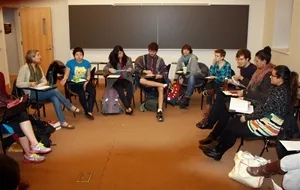A Tradition of Student-Led Courses

Student-led courses have been a part of the Swarthmore tradition for decades. Over the years, courses have ranged in scope and interest, from Zionism, nuclear issues, and science fiction in the '80s to women's health care, Japanese language, and computer graphics in the '90s, among others. More recently, they have included a practicum in social justice and fiction and poetry workshops. This semester, Locations of Self: Introduction to Ethnic and Cultural Studies is being offered. Its impetus - a Fall 2012 student-led introductory course on ethnic studies spearheaded by Shelly Wen '14 of Mesa, Ariz.
A special major in multicultural education, Wen initiated the course last fall after taking an introductory class on race and ethnicity last spring by Visiting Assistant Professor of Sociology and Black Studies Nina Johnson. She also researched student-led ethnic studies interests at Swarthmore for a course on activism among Asian-American communities.
"I was inspired and I wanted to explore more," says Wen. "I thought a student-run course would be a way of addressing the need for this kind of analysis in the classroom while giving students interested in pursuing ethnic studies a means of academically exploring this subject."
Students are permitted to propose a topic to a faculty member for 0.5 or 1 credit and to run the course with a reading list approved by the faculty member. All course credits must be departmentally approved and have a faculty advisor. There have been several non-credit student-run courses sponsored by the Career Services Office.
"Shelly asked important questions about topics we were not able to cover that semester," says Johnson. "There are always gaps in what we can adequately accomplish in a semester. That's why it's important for these kinds of structures to be in place to respond to student demand and to support demonstrated intellectual interest both in the short and long term."
Wen teamed up with sociology and anthropology major Anna Stitt '13 of West Fork, Ark., to draft a proposal for the course. Together they worked with Provost Thomas Stephenson and Acting Chair of Sociology Farha Ghannam to get the necessary approval.
In all, approximately 30 students majoring in a variety of fields took time out from their full course loads to discuss analytical texts and blog posts during the Thursday night class. A different group of students led the class each week, sometimes with a special guest. The structure of the classes varied from "fishbowl" to lively debates to pedagogy analysis. Together, students examined the history of ethnic studies, approaches to ethnic studies as an academic discipline, media representations of race, food justice and land ownership, microagressions, and positionality.
Johnson led the discussion, "Positionality, Reflexivity, and the Work," which she described as the highlight of her semester. Alina Wong, dean of the sophomore class and director of the Intercultural Center, facilitated a discussion on intersectionality and racial identity construction using some of her most recent scholarship which will soon be published in a new book on intersectionality in higher education research.
"In addition to the group of students who attended class each week, more students came as the semester progressed," says Stitt. "A couple of students initially came to support a friend who was facilitating a class, but several ended up coming back because the discussions filled a need."
With guidance from Johnson, Wen and Stitt coordinated the course. Johnson also met with student facilitators to deliberate on the focus of each class.
"There may be an assumption that a student-led course will be somewhat easier," says Johnson. "But in my experience, I have found that student-led courses can in fact be quite rigorous because the students are passionate about the subject and bring a high level of engagement and investment to the work, above and beyond their already intense work load."
Toward the close of "Introduction to Ethnicity," Mike Lumetta '15 of Chesterfield, Mo., like Wen, yearned for more time to cover topics that weren't discussed during the semester. "There was always so much more to talk about and so much more we could go into," he says. "The challenge was finding enough time to talk about it all."
Fittingly, the final project of the course steered students to create a lesson plan for a three-hour ethnic studies class that would probe the questions that were not investigated this time around.
"Overall, the course was a wonderful learning experience," says Wen. "I not only got the opportunity to critically engage with other students and Professor Johnson on ethnic studies, a topic very important to me, but also take a leadership role in an ongoing effort."



